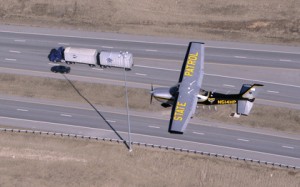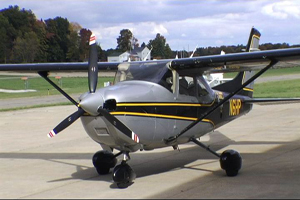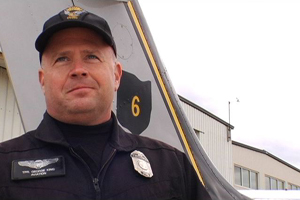Bear in the Air

Flying over the Rt 33 bypass in Lancaster, Ohio. SOURCE: Craig Holman, Columbus Dispatch)
COLUMBUS, Ohio — Most wouldn’t be surprised to hear Ohio State Trooper George King is on the lookout for marijuana fields and highway speeders. But few would guess where he’s hiding: in the clouds.
King works for the aviation section of the Ohio State Highway Patrol. He flies a Cessna 182, which is nothing like the jetliners most people think of when they hear the word airplane.
Another Day, Another Airplane
King’s airplane has a small cockpit. It has the distinguished gray and black markings of the State Highway Patrol painted along the sides. Some of the planes say “state patrol” across the top of the wings. King said the plane he flies each day depends on the maintenance rotation, so he could be flying a different one everyday.
As a child, King says he always imagined himself embarking on a career with a lot of adventure. He’s glad for his in-flight escapades and the positive contribution to society he makes as a trooper.
“When you bring those two together,” he says, “I don’t think I’d choose to be anyplace else.”
Originally from Columbus, King graduated from Brookhaven High School and then from Ohio Dominican College. He is currently a student at Embry-Riddle Aeronautical University, working toward his master’s degree.
Not only does he have the academic background that contributes to his success as a trooper pilot, but he is also a military veteran. King says his experience as a Marine provided many interesting situations and contributed to his career in law enforcement. He compared becoming a pilot to military boot camp because of the tedious, highly-structured process.

One of the airplanes George King uses to patrol the skies of Northeast Ohio's District Four.
A Pilot is First a Trooper
King says the process of becoming a trooper pilot is lengthy. First, a person must be accepted as a trooper, then attend the residential academy, which is six-months long. Once graduated, the trooper will go through training with a seasoned ground officer and spend time on the road. Once an aviation position opens, the trooper will go through an interview process and spend four months training with an experienced trooper pilot.
“You have to be focused,” he says. “You have to want to do it and do what it takes to get through.”
King says he is apprehensive when using the words “average” or “routine” when explaining a day in the life as a trooper pilot.
“You never know what you’re going to come across,” he says.
Typically, however, a day in the life of George King, starts around 8 a.m. (on the days he isn’t assigned the night shift). He checks the weather and finds out if there’s anything else that might affect the flight, such as maintenance issues. By 8:30, he’s off.
As a pilot in District Four, King says he patrols the northeast quadrant of Ohio, including areas of Lisbon, Ravenna, Ashtabula, Youngstown and Cleveland. He spends the first part of his shift working with ground units in traffic enforcement. He is the one who looks for the violation and then advises the ground unit waiting nearby. The violations vary from speeding and following too close to erratic driving. After the intercept is made, King goes back and does the same thing with the next unit.
“It’s efficient,” he says. “We probably make somewhere in the vicinity of 30,000 law enforcement contacts every year throughout the state of Ohio. That’s about 10 or 11 of us doing that.”
Randy Boggs, section commander and staff lieutenant of Ohio’s aviation unit, works closely with King. Not only do they work on traffic enforcement, but they also get involved in searches for escaped convicts, missing children and mentally-ill patients.
Saving Lives From the Air
“When we do find the lost kid in the state park or we find the Alzheimer patient that wandered away,” Boggs says, “you come back feeling pretty good because potentially you could’ve saved that person’s life.”

George King, Ohio trooper/pilot, on the ramp of the Portage County Airport.
While King’s wife and three children are supportive of his career, he says they are also aware of the risks and time constraints involved with law enforcement and aviation. He says family time depends on his schedule, so afternoon and night shifts create a little more of a challenge.
Recently, King took off out of a local airport and looked over his shoulder at what appeared to be a large marijuana field. He said it turned out to be 227 plants, each growing at least 6-feet tall. One plant had a street value of $1,000. King contacted the local sheriff, who then inventoried the field and, with a court order, properly destroyed it.
“We’re a 24-7 operation,” he says. “There is always something to be aware of, whether it’s the status of the flight and operating the aircraft, or the mission at hand.”
Also see, “Aerial Traffic Control,” and “Out of Sight.”
Rebekah Maple is a senior magazine journalism major at Kent State University.
[…] see, “Bear in the Air” and “Out of […]
[…] see, “Bear in the Air” and “Ohio’s History of Aerial Traffic […]